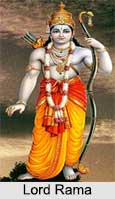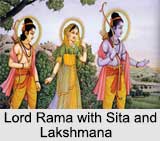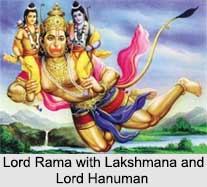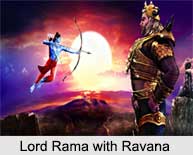 Lord Rama is principally important to "Vaishnavism". He is the fundamental figure of the ancient Hindu epic Ramayana. He is the most famous incarnation of God whose day of appearance is known as "Ramnavami". He is known to be the seventh incarnation of Lord Vishnu. He had all qualities of the all-pervasive Brahman in him.
Lord Rama is principally important to "Vaishnavism". He is the fundamental figure of the ancient Hindu epic Ramayana. He is the most famous incarnation of God whose day of appearance is known as "Ramnavami". He is known to be the seventh incarnation of Lord Vishnu. He had all qualities of the all-pervasive Brahman in him.
Birth of Lord Rama
Rama was born to Kaushalya and Dasharatha in Ayodhya, the ruler of the Kingdom of Kosala. His siblings included Lakshmana, Bharata, and Shatrughna. He was born on the ninth day of the lunar month "Chaitra" which is celebrated across India as "Ramnavami". He was born at the end of the Second Age or Treta-Yuga.
Etymology of Lord Rama
Rama is a Sanskrit word with two related meanings. In one context as found in "Arthavaveda" and in another context as found in other Vedic texts, the word means "pleasant, enchanting, appealing, attractive, and lovely". His name had an important meaning; it"s composed of two "beeja aksharas" - the "Agni Beeja" (Ra) and the "Amrutha Beeja" (Ma). While the "Agni Beeja" served to encourage his soul and body, the "Amrutha Beeja" revived him from all the exhaustion.
Iconography of Lord Rama
As a person, Rama personifies the description of an ideal person. Rama is considered a "maryada purushottama" or the best of upholders of Dharma. He had all the enviable virtues that any character would seek to wish inside of him, and he fulfilled all his ethical commitments.
Legends of Lord Rama
Rama"s first exploration happened when the sage Viswamitra asked for help out in fighting with a demon. Rama and Lakshmana followed Viswamitra to his home and there killed female demon Taraka. In gratefulness, Rama was given heavenly weapons and set off for more adventures, ending up in Mithila. Rama wins the contest by breaking Lord Shiva`s bow in Mithila and King Janaka agreed to the marriage of Sita and Rama. Sita moved with Rama to his father Dashratha`s capital. Another incarnation of Lord Vishnu, Parshuram had once challenged Lord Rama to string Lord Vishnu"s bow. Lord Rama accepted the challenge and completed it quite effortlessly.
While Rama and his brothers were away, queen Kaikeyi, the mother of Bharata and the second wife of king Dasharatha, reminded the king that he had promised long ago to fulfil her one wish. Dasharatha remembered and agreed to accomplish so. She demanded that Rama be banished for fourteen years to "Dandaka" forest. Dasharatha mourned at her request and Bharata, along with other family members become upset at her demand. Rama stated that his father should keep his word. He talked about his conclusion with his wife and Sita left with him for the exile. Lakshmana joined them in their exile as well.
 Initially they stayed at "Chitrakuta", on the banks of river Mandakini. Rama explored the forests and lived a poor simple life. After ten years of travelling and struggles, Rama along with Sita and Lakshmana arrived at "Panchavati", on the banks of river Godavari. One day, a demoness Shurpanakha saw Rama and wanted to marry him. Rama declined her and for this Shurpanakha retaliated by frightening Sita. Lakshmana in turn retaliated by cutting off the nose and ears of Shurpanakha. Shurpanakha then told everything to her brother demon king Ravana. Ravana came to "Panchavati" to take revenge, saw Sita and kidnapped her to his kingdom.
Initially they stayed at "Chitrakuta", on the banks of river Mandakini. Rama explored the forests and lived a poor simple life. After ten years of travelling and struggles, Rama along with Sita and Lakshmana arrived at "Panchavati", on the banks of river Godavari. One day, a demoness Shurpanakha saw Rama and wanted to marry him. Rama declined her and for this Shurpanakha retaliated by frightening Sita. Lakshmana in turn retaliated by cutting off the nose and ears of Shurpanakha. Shurpanakha then told everything to her brother demon king Ravana. Ravana came to "Panchavati" to take revenge, saw Sita and kidnapped her to his kingdom.
Rama and Lakshmana travelled to the south and met Sugriva who had an army of monkeys, with committed commanders like Lord Hanuman. Rama helped to re-establish Sugriva"s power. Sugriva gave Rama the use of his army and the help of Hanuman as a sign of greatness. A series of massive battles between Rama forces and the demon followed and finally Ravana was defeated. Rama was doubted that his wife had not remained loyal to him during her kidnap. Sita was determined to establish her honour by a test of fire. Then Rama realized he had misjudged Sita, and they headed back for Ayodhya. Rama exiled Sita to live with the sage Valmiki, and she gave births to the twin sons, "Kusha" and "Lava". Eventually, the sons come back to "Ayodhya" where Rama recognized his children. Still declaring her virtue, Sita then pledged her virtue on the earth itself, which then rapidly swallowed her. Rama, now even more distressed, promised to go after his wife to heaven, but time appeared to him in the appearance of a severe and told him to stay and complete his duty on earth. Nevertheless, Rama wades into the river Sarayu and from there is welcomed into heaven by Lord Brahma.
Festivals of Lord Rama
Rama Navami is a spring festival that celebrates the birthday of Rama. Rama`s life is celebrated every year with theatrical plays in autumn. This is called "Ramlila", and the play follows Ramayana. After the performance of the celebrated war between Good and Evil, Ramlila celebrations climax in the Dussehra night celebrations. In some parts of India, Rama`s homecoming to Ayodhya is the main explanation for celebrating Diwali.
Temples of Lord Rama
Important Rama temples include:

•Ram Janmabhoomi, Ayodhya
•Kalaram Temple, Nashik
•Raghunath Temple, Jammu
•Ram Mandir, Bhubaneswar, Odisha
•Kodandarama Temple, Hampi
•Kothandarama Temple, Tamil Nadu
•Kothandaramaswamy Temple, Rameswaram
•Odogaon Raghunath Temple, Odisha
•Ramchaura Mandir, Bihar
•Sri Rama Temple, Ramapuram
•Bhadrachalam Temple, Telangana
•Shree Rama Temple, Triprayar, Kerala
Lord Rama"s rule over Ayodhya was regarded as its golden period and run for eleven thousand years. Lord Rama took "Jal Samadhi" in the Sarayu River and as a result left the earth eternally.




















